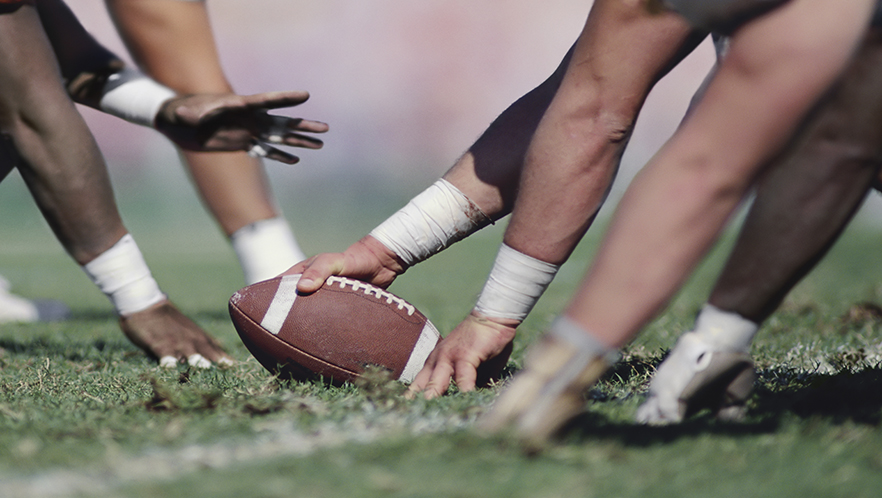You’re ready for some football, but what about your TV?
With the kickoff of the college and pro seasons, millions of Americans will be spending hours at home watching games. With today’s televisions, there’s no better place to root for the home team.
We talked to Mike Dye, a Magnolia home theater expert at our Best Buy store on Manhattan’s Upper West Side, to get his playbook for how to choose the right TV for catching all the football action this season.
Here are four stats you need to know when you go TV shopping. For that extra point, we added a bonus tip.
Refresh rate (Hertz)
Refresh rate is the TV equivalent of a wide receiver’s time in the 40-yard dash — it’s all about speed. This number, measured in hertz (Hz), tells you how many times per second the image on the screen refreshes.
Most TVs have refresh rates of 60Hz and 120Hz. A higher number usually means the TV can better keepi up with the action on the football field. You’ll get a smoother picture with less blur.
Some manufacturers are promoting similar numbers that go by slightly different names, such as “motion rate.” Those numbers, which can reach 240Hz or even 480Hz, aren’t the same as the refresh rate. Instead, they represent what the manufacturer thinks the picture can look like with the aid of the TV’s internal blur-reduction software.
“But that can also result in the so-called ‘soap opera effect’ where the motion almost gets a little too fluid, sort of like it was shot on a camcorder in the 1980s,” Mike said. “For the best results, try turning down the motion software — or even turning it off — if you get a panel with a high refresh rate.”
Resolution (Pixels)
4K, or Ultra High Definition, is the new standard for today’s premier TVs. With four times as many pixels as high-definition 1080p, these TVs are able to show much more detail.
Very few sporting events are broadcast in 4K, but all of the 4K TVs at Best Buy have the ability to “upconvert” content to near-4K quality.
“It’s important to remember that when you’re watching sports on TV, that’s probably 720p, which isn’t even a quarter of what your TV can do,” Mike said. “So the ability to take that lower-res content and knock it up is incredibly important.”
Screen size (Inches)
For many sports fans, TVs are like offensive linemen — the bigger the better. With 4K technology, you can go bigger than you used to, even in smaller spaces like New York City apartments.
“With 4K TVs, and especially for sports, you can get a really nice picture at really big sizes,” Mike said. “If you do get a higher-quality TV, you can actually sit quite close and still be very happy with the quality.”
And, while 4K looks great in any size, you’ll actually notice the biggest difference in picture quality on a larger screen because that’s where the added pixel density is most impressive.
“If money’s no object, you can go as big as you want,” Mike said. “But, otherwise, keep in mind that the same budget will either get you a better small TV or a more basic big TV.”
Budget (Dollars)
Mike says it’s a good idea to know how much you want to spend before you stop by a store. It will make it easier for an expert Blue Shirt to help you find exactly what you’re looking for.
You don’t have to spend your whole paycheck to get a good TV for game day, either.
“Good TVs are available at all price points,” Mike said.
But, when budgeting, don’t forget to account for accessories such as soundbars. Most of today’s TVs are so slim that there isn’t room for decent speakers inside them.
“If you want to hear everything the announcer’s saying and still hear the roar of the crowd, some type of audio can be really helpful,” Mike said.
Extra point: Color accuracy
There isn’t really a key stat to look for here, so you’ll have to do some old-school scouting of your own to see which TVs pass the eye test. Mike recommends using your favorite football team’s uniform colors as a guide of what to look for.
“There’s a good chance you have a jersey from your favorite team, and you know what that color is supposed to look like,” he said. “That’s a good opportunity to get a feel for how that TV’s really performing for color accuracy.”
Greens are particularly difficult for some TVs to reproduce, so the field itself can be another good test.
“Make sure it looks like real grass,” Mike said. “When I watch a TV where the color isn’t accurate, it’s all that I can see.”
Click here to view Best Buy’s 4K Ultra HD TV Buying Guide for more information on the latest television technology.


